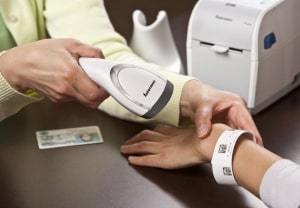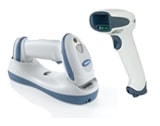Why Use Medical Bracelets with Barcodes in Hospitals?
 The use of medical barcode bracelets enables hospital workers to greatly reduce the incidence of medication errors in the hospital which could be caused by confusion about the identity of the patient. The unique barcode allows data about the patient and medical procedures to be centrally stored and easily accessed by those who are authorized. The barcode system, when used with a reader, allows for proper identification of the patient when delivering medications or taking specimens for analysis. The hospital worker who is directly working with the patient will be able to verify if the correct procedure is being applied to the patient in question.
The use of medical barcode bracelets enables hospital workers to greatly reduce the incidence of medication errors in the hospital which could be caused by confusion about the identity of the patient. The unique barcode allows data about the patient and medical procedures to be centrally stored and easily accessed by those who are authorized. The barcode system, when used with a reader, allows for proper identification of the patient when delivering medications or taking specimens for analysis. The hospital worker who is directly working with the patient will be able to verify if the correct procedure is being applied to the patient in question.
The use of barcodes on wristbands allows all the information about the patient to be accessible to the hospital workers without compromising any of the privacy of the patient.
Patient identification wristbands can be used to keep track of a variety of patients in a hospital including those who have entered emergency to await treatment, those who have been admitted, and those who are having surgery performed.
The system for keeping creating bracelets for patients and for maintaining patient information must be smoothly integrated and controlled. Creating a patient identification bracelets for the hospital environment is especially challenging since there is a high need for a very strong material that cannot be removed or lost until it is time for the patient to leave the hospital. The material must be light in weight yet extremely durable. It must not be affected by heat, light, perspiration, cleaning chemicals, or electromagnetic energy fields.
Errors In Barcode Readings
Despite the fact that introduction of the wristband and barcode system has resulted in reduced errors in patient identification, there is still the potential of errors occuring in the system. Although quite infrequent (1 in 84,000 scanning events), barcode readers can occasionally give faulty readouts if the printing on the bracelet or ribbon has become worn or blurred because of too much wear and tear. For this reason it is essential that the material of the wristband and the ink are extremely durable and that the image quality will be maintained even after a long period of use on the patient. Minor imperfections in printing can lead to faulty readings. In some instances, the printer head becomes clogged and the device will produce a barcode which will be misread.
Metallic Content in Bracelets Can Be a Danger
Medical bracelets used for patient identification must not have any metallic content in either the wristband material or the ink used for patient information and barcode printing. Even small amounts of metal can lead to dangerous situations during MRI procedures.
Zebra Thermal Printers Offer More Durable Barcodes
Direct thermal printing on the new generation of Zebra Wristbands is more durable than laser-printed barcodes. Barcodes produced by laser printers do not hold up as well in a hospital setting as thermal-printed barcodes. The new Zebra Wristbands are stronger, cheaper, and easier to read. These Wristbands have an antimicrobial coating to help prevent the spread of disease organisms in the hospital.
Choosing the right scanner: Honewell Xenon 1902h
 Xenon 1902h, designed specifically for healthcare, is redefining the standard for hand-held scanners. Honeywell’s sixth-generation of area imaging technology features a custom sensor that is optimized for bar code scanning. With industry-leading performance and reliability, the Honeywell Xenon 1902h is well suited for a wide variety of healthcare applications that require the versatility of area-imaging technology plus the freedom of Bluetooth® wireless connectivity.
Xenon 1902h, designed specifically for healthcare, is redefining the standard for hand-held scanners. Honeywell’s sixth-generation of area imaging technology features a custom sensor that is optimized for bar code scanning. With industry-leading performance and reliability, the Honeywell Xenon 1902h is well suited for a wide variety of healthcare applications that require the versatility of area-imaging technology plus the freedom of Bluetooth® wireless connectivity.